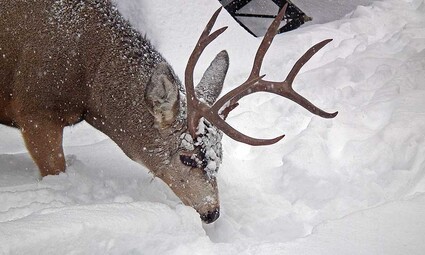Wildlife census could impact Sisters Country
Last updated 1/11/2023 at Noon

COURTESY ODFW
A county wildlife overlay zone is likely to be a contentious land-use issue in coming months.
Oregon has one of the most robust land use and planning protocols in the nation, and LUBA — the Land Use Board of Appeals — has been the center of disputes for decades between advocates and opponents of growth. The year 2023 will no doubt be a year of controversy in the long running debate about best stewardship practices when Deschutes County resumes consideration of updating its wildlife inventory.
In the face of declining mule deer numbers, and greater concern for the protected range of elk and bald and golden eagles, biologists are signaling the possible need for more restrictions on private property owners.
In 2021 an interagency working group in collaboration with Dr. Wendy Wente under a grant from Oregon Department of Land Conservation undertook the initial phase to update Deschutes County’s wildlife inventory last taken some 30 years ago. The group’s assessment was that all three of the County’s current data sets did not currently align with the best available science.
“They are out of date and land use changes can conflict with the long-term maintenance of these wildlife resources,” their summary report said.
There were two public open houses, April 15 and April 20, 2021. A summary report was issued the following month. In November 2021, based on the results of Phase 1, the Board of County Commissioners directed Community Development Department staff to initiate a pilot project updating the proposed new inventory only for mule deer winter range.
The project’s priority was pushed downward as in 2022 staff had to respond to Ballot Measure 9-152 regarding psilocybin therapy or production in the County, which passed. Additionally the impact of SB 391 that went into law June 23, 2021 covering the rules for ADUs (accessory dwelling units) in rural areas pushed the Wildlife Inventory project farther down the to-do list.
Now it’s back, included in the upcoming agenda of the seven-member Deschutes County Planning Commission’s meeting of January 12. If it progresses, planners expect it to be one of their biggest undertakings ever, according to Senior Planner Tanya Saltzman, who also expects the range of possible restrictions and prohibitions on private lands to be contentious.
Saltzman said there will be numerous opportunities for public input and the process could take as long as a year.
The WA (Wildlife Area) zone is an overlay zone that adds requirements to the base zone (ex. MUA, EFU, RR- 10) in which a lot or parcel is located. The purpose of the WA zone is to conserve important wildlife areas and to permit development compatible with the protection of wildlife areas.
The current WA Zone for mule deer winter range covers approximately 315,847 acres. Based on the assessment performed in the Phase 1 grant, the IWG (Interagency Working Group) with input for ODFW (Oregon Department of Fish and Wildlife), authors say that the range would need to increase by 188,132 acres, roughly half of which would be in Sisters Country.
Already on the books, if your property is in the WA zone you are prohibited from building or operating a golf course, commercial dog kennel, church, public or private school, bed and breakfast, dude ranch, playground, recreation facility or community center, timeshares, fishing lodge, veterinary clinic, or fishing lodge.
If your land winds up in the expanded zone you would likely be restricted in where you could site your home. Instead of that panoramic knoll in the center of your acreage or adjacent to a babbling stream on the back 40, you would be forced to build no more than 300 feet from the public road.
New fences in conjunction with new development in the wildlife areas need to be designed to let wildlife pass over or under the fence, which could limit your ability to raise livestock or keep horses.
Already recorded in the public input record are concerns by skeptical farmers and ranchers, who view the proposals as nothing more than thinly veiled disguises at limiting growth in the County. Proponents are adamant that measures must be taken to mitigate the declining deer population.
Much of the impetus for the inventory update is driven by Goal 5 requirements mandated by Oregon Land Conservation and Development Department pursuant to Chapter 660.
The debate is often hot between biologists and landowners as to the biggest cause of deer’s decline. The ODFW estimates that there are 6,000 cougars in Oregon with a weekly diet of one deer — 312,000 annually. Likewise, ranchers say, deer are often bunched near water in preservation efforts that lead to disease and erode streams.
As deer escape cougar predation they settle in more populated areas, where their health and safety is not as good as when left in the wild. Studies show that deer-vehicle collisions, tickborne pathogens, and garden poisoning are major causes of deer loss in cities and towns.
Given the scope of the project, Saltzman said it will be limited to deer only for now, with an inventory of elk and birds to follow.

















Reader Comments(0)